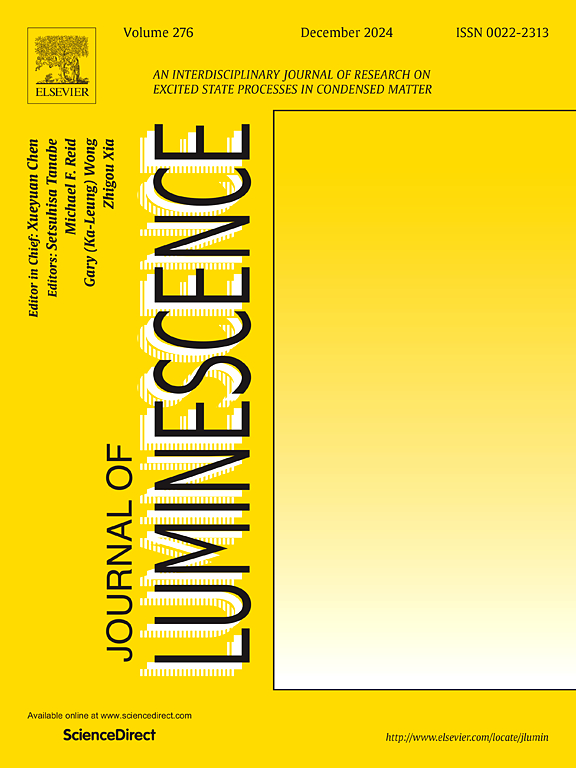Extended dosimetric characterization and kinetic analysis of newly developed Li2B4O7:Cu,Ag thermoluminescent dosimeter
IF 3.3
3区 物理与天体物理
Q2 OPTICS
引用次数: 0
Abstract
This study extended the dosimetric characterization and kinetic analysis of the previously developed Li2B4O7:Cu,Ag thermoluminescent dosimeter (LTB:Cu,Ag TLD). The current study included the dose-response study in a higher dose region, determination of Zeff (tissue equivalency), investigation of energy and dose rate dependency, reusability assessment, and kinetic parameters analysis using further experimental techniques (VHR and PS). The glow curve of LTB:Cu,Ag TLD exhibited stable characteristics for higher doses ranging from 20 to 50 Gy. The dosimeters displayed supralinear dose response above the 20 Gy threshold, with a maximum supralinearity f(D) of 1.47. The value of Zeff was 7.63 as calculated from ICP-OES data to be nearly tissue equivalent (Zeff = 7.35–7.6). The dosimeter was irradiated with photons of reference radiation qualities spanning from 33 to 1252 keV. A slight increase in TL sensitivity was observed at lower X-ray energies <100 keV. The over response was found to be maximum (34 %) at ∼ 48 keV. A negligible dose rate effect was observed (variations up to 2.52 %). Reusability was examined over 50 cycles and bench marked against the standard dosimeter (LiF:Mg,Ti) with results being the same for both the dosimeters. Kinetic parameters were investigated using complementary VHR and PS methods, yielding consistent results with the previously employed CGCD and Tm-Tstop techniques.
新研制的Li2B4O7:Cu,Ag热释光剂量计的扩展剂量学表征及动力学分析
本研究扩展了先前开发的Li2B4O7:Cu,Ag热释光剂量计(LTB:Cu,Ag TLD)的剂量学表征和动力学分析。目前的研究包括高剂量区域的剂量-反应研究,组织等效性(Zeff)的测定,能量和剂量率依赖性的研究,可重复使用性评估,以及使用进一步的实验技术(VHR和PS)进行动力学参数分析。LTB:Cu,Ag TLD的发光曲线在20 ~ 50 Gy的高剂量范围内表现出稳定的特性。剂量计在20 Gy阈值以上显示超线性剂量响应,最大超线性f(D)为1.47。根据ICP-OES数据计算Zeff值为7.63,接近组织等效(Zeff = 7.35-7.6)。用参考辐射质量为33至1252 keV的光子照射剂量计。在较低的x射线能量(100 keV)下观察到TL灵敏度略有增加。在~ 48 keV时发现过度反应最大(34%)。观察到的剂量率效应可忽略不计(变化高达2.52%)。在50多个循环中检查了可重复使用性,并与标准剂量计(LiF:Mg,Ti)进行了对照试验,两种剂量计的结果相同。利用互补的VHR和PS方法研究了动力学参数,得到了与之前使用的CGCD和Tm-Tstop技术一致的结果。
本文章由计算机程序翻译,如有差异,请以英文原文为准。
求助全文
约1分钟内获得全文
求助全文
来源期刊

Journal of Luminescence
物理-光学
CiteScore
6.70
自引率
13.90%
发文量
850
审稿时长
3.8 months
期刊介绍:
The purpose of the Journal of Luminescence is to provide a means of communication between scientists in different disciplines who share a common interest in the electronic excited states of molecular, ionic and covalent systems, whether crystalline, amorphous, or liquid.
We invite original papers and reviews on such subjects as: exciton and polariton dynamics, dynamics of localized excited states, energy and charge transport in ordered and disordered systems, radiative and non-radiative recombination, relaxation processes, vibronic interactions in electronic excited states, photochemistry in condensed systems, excited state resonance, double resonance, spin dynamics, selective excitation spectroscopy, hole burning, coherent processes in excited states, (e.g. coherent optical transients, photon echoes, transient gratings), multiphoton processes, optical bistability, photochromism, and new techniques for the study of excited states. This list is not intended to be exhaustive. Papers in the traditional areas of optical spectroscopy (absorption, MCD, luminescence, Raman scattering) are welcome. Papers on applications (phosphors, scintillators, electro- and cathodo-luminescence, radiography, bioimaging, solar energy, energy conversion, etc.) are also welcome if they present results of scientific, rather than only technological interest. However, papers containing purely theoretical results, not related to phenomena in the excited states, as well as papers using luminescence spectroscopy to perform routine analytical chemistry or biochemistry procedures, are outside the scope of the journal. Some exceptions will be possible at the discretion of the editors.
 求助内容:
求助内容: 应助结果提醒方式:
应助结果提醒方式:


